The SMD TVS diodes market is valued at USD 1,782.8 million in 2025 and is projected to reach USD 3,813.5 million by 2035, registering a CAGR of 7.9%. Over the forecast period, the market will nearly double, reflecting strong demand growth driven by expanding applications in electronics protection, automotive systems, consumer electronics, and industrial automation. This consistent expansion reflects a stable long-term growth trajectory supported by increasing electronic device penetration and rising requirements for surge protection solutions. The CAGR of 7.9% confirms a robust annual growth pattern that is underpinned by innovation in diode technology and broader adoption in next-generation electronics.
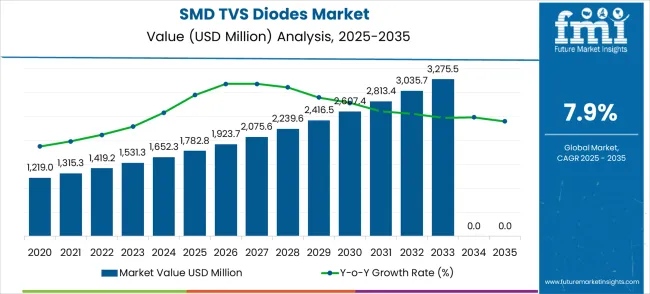
From 2025 to 2028, the market grows from USD 1,782.8 million to USD 2,239.6 million, with annual increments ranging from USD 140.9 million to USD 164.0 million. This early phase records an average YoY growth rate of approximately 7.9%, showing consistency in expansion. The largest annual percentage change in this period occurs in 2026, at about 7.9%, driven by rapid adoption of advanced protective components for smartphones, automotive electronics, and renewable energy systems. This period also reflects steady growth without significant volatility, supported by steady demand and stable raw material pricing.
| Metric | Value |
|---|---|
| Market Value (2025) | USD 1,782.8 million |
| Market Forecast Value (2035) | USD 3,813.5 million |
| Forecast CAGR (2025–2035) | 7.9% |
The mid-phase, from 2029 to 2032, sees the market advance from USD 2,416.5 million to USD 3,035.7 million, adding USD 619.2 million, which accounts for about 33.5% of the total decade growth. Annual growth rates remain strong, averaging around 7.7%, with the highest growth in 2031 at approximately 8.0%. This acceleration is linked to increasing integration of SMD TVS diodes in industrial IoT, automotive safety systems, and high-speed data communications. The growing complexity of electronic systems and higher reliability requirements bolster demand, while competition among manufacturers drives efficiency improvements and cost optimization.
Between 2033 and 2035, the market grows from USD 3,275.5 million to USD 3,813.5 million, representing an increase of USD 538.0 million, or about 29.8% of the total growth over the decade. Annual percentage changes in this phase average around 7.8%, with a slight deceleration compared to mid-phase growth, reflecting market maturation. Volatility remains low, showing a predictable growth trend. The average YoY growth for the decade is approximately 7.9%, confirming a stable upward trend in the market, with strong long-term potential driven by constant demand across diverse electronic applications.
Market expansion is being supported by the rapid proliferation of electronic devices across consumer, automotive, and industrial sectors, creating unprecedented demand for reliable circuit protection solutions. Modern electronic systems require precise voltage regulation and transient suppression to ensure optimal performance and prevent component damage from voltage spikes, electrostatic discharge, and electromagnetic interference. The superior response time and compact form factor of SMD TVS diodes make them essential components in space-constrained applications where traditional protection methods are impractical.
The growing focus on electronic device reliability and the increasing complexity of integrated circuits are driving demand for advanced protection technologies from certified manufacturers with proven track records of quality and performance. Electronic system designers are increasingly investing in high-quality TVS diodes that offer superior clamping characteristics and lower capacitance for high-speed signal integrity. Regulatory requirements and industry standards are establishing performance benchmarks that favor precision-engineered SMD TVS diodes with advanced packaging technologies and enhanced thermal management capabilities.
The automotive industry's transition toward electrification and autonomous driving technologies is creating substantial demand for robust protection solutions capable of operating in harsh automotive environments. Consumer electronics manufacturers are driving innovation in miniaturization while maintaining protection performance, leading to development of ultra-small form factor TVS diodes with improved power handling capabilities.
The market is segmented by product type, application, and region. By product type, the market is divided into unidirectional type and bidirectional type configurations. Based on application, the market is categorized into consumer electronics, automotive, industrial automation, telecommunications, and others. Regionally, the market is divided into North America, Europe, East Asia, South Asia & Pacific, Latin America, and Middle East & Africa.
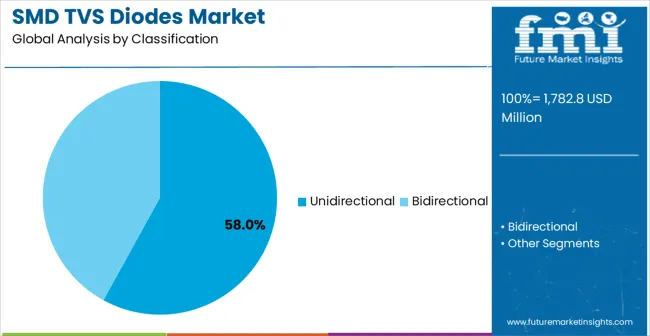
Unidirectional type configurations are projected to account for 58% of the market in 2025. This leading share is supported by the widespread adoption in DC power supply protection applications and growing demand for specialized protection in single-polarity voltage systems. Unidirectional TVS diodes provide superior clamping performance for applications where current flow direction is predictable, making them the preferred choice for power management circuits, battery charging systems, and DC motor control applications. The segment benefits from technological advancements that have improved the reverse leakage characteristics while reducing forward voltage drop.
Modern unidirectional SMD TVS diodes incorporate advanced semiconductor junction designs and optimized doping profiles that enhance breakdown voltage accuracy and temperature stability. These innovations have significantly improved protection reliability while reducing parasitic capacitance for high-frequency applications. The automotive electronics sector particularly drives demand for unidirectional solutions, as these systems require absolute protection reliability to prevent costly system failures and ensure passenger safety compliance.
The renewable energy sector increasingly adopts unidirectional TVS diodes to protect solar panel control systems and wind turbine electronics from transient voltage events. The growing deployment of DC fast charging infrastructure for electric vehicles creates substantial opportunities for specialized unidirectional TVS diodes designed for high-power applications.
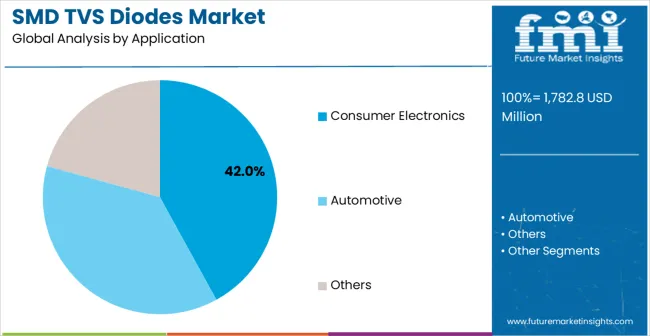
Consumer electronics applications are expected to represent 42% of SMD TVS diodes demand in 2025. This dominant share reflects the critical role of circuit protection in smartphones, tablets, laptops, and smart home devices where component reliability directly impacts user experience. Consumer electronics manufacturers require compact and efficient TVS diodes capable of protecting sensitive integrated circuits from electrostatic discharge, power supply transients, and electromagnetic interference while maintaining signal integrity in high-speed data interfaces.
The smartphone industry drives significant demand for ultra-miniature TVS diodes that provide multi-channel protection for USB interfaces, camera modules, and wireless communication circuits. These applications require TVS diodes with extremely low capacitance to avoid signal degradation while providing fast response times for effective transient suppression. The segment benefits from continuous innovation in packaging technologies that enable higher power handling in smaller form factors.
Gaming consoles, smart TVs, and IoT devices contribute substantially to market growth as manufacturers implement comprehensive protection strategies to improve product reliability and reduce warranty costs. The growing adoption of wireless charging technologies creates opportunities for specialized TVS diodes designed for high-frequency power transfer applications. The trend toward higher data rates in consumer devices drives demand for TVS diodes with ultra-low capacitance and excellent signal integrity characteristics.
The SMD TVS diodes market is advancing rapidly due to increasing electronic system complexity and growing recognition of circuit protection importance across all technology sectors. The market faces challenges including intense price competition, need for continuous miniaturization, and varying performance requirements across different electronic applications. Standardization efforts and qualification programs continue to influence component selection and market development patterns.
The growing adoption of wafer-level chip-scale packaging (WLCSP) and flip-chip technologies is enabling significant size reduction while improving thermal performance and electrical characteristics in TVS diode applications. Advanced packaging techniques provide better heat dissipation and lower parasitic inductance, enabling faster response times and higher power handling capabilities. These technologies are particularly valuable for mobile device applications that require maximum protection performance in minimal space.
Modern TVS diode manufacturers are developing specialized products tailored to specific application requirements, including automotive-grade components for harsh environment operation, ultra-low capacitance devices for high-speed data interfaces, and high-power solutions for industrial and renewable energy applications. Advanced simulation and modeling techniques enable precise optimization of electrical characteristics for targeted applications while maintaining cost-effectiveness and manufacturing scalability.
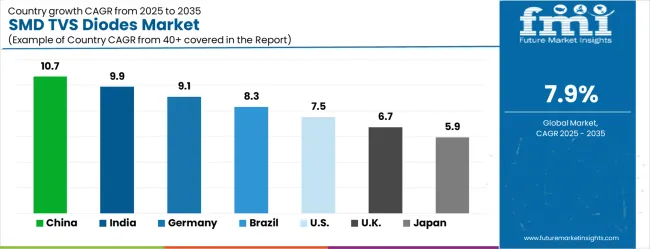
| Country | CAGR (2025-2035) |
|---|---|
| China | 10.7% |
| India | 9.9% |
| Germany | 9.1% |
| Brazil | 8.3% |
| United States | 7.5% |
| United Kingdom | 6.7% |
| Japan | 5.9% |
The market is growing rapidly, with China leading at a 10.7% CAGR through 2035, driven by massive electronics manufacturing expansion, smartphone production growth, and electric vehicle industry development. India follows at 9.9%, supported by rising consumer electronics manufacturing and increasing automotive electronics adoption. Germany records strong growth at 9.1%, focusing automotive industry innovation and industrial automation advancement. Brazil grows steadily at 8.3%, integrating protection solutions into expanding electronics assembly operations. The United States shows robust growth at 7.5%, focusing on advanced semiconductor development and automotive electronics innovation. The United Kingdom maintains solid expansion at 6.7%, supported by telecommunications infrastructure upgrades. Japan demonstrates stable growth at 5.9%, focusing technological innovation and manufacturing excellence.
The report covers an in-depth analysis of 40+ countries; top-performing countries are highlighted below.
China is forecasted to grow at a CAGR of 10.7% between 2025 and 2035, driven by its rapidly expanding electronics manufacturing sector and increasing production of consumer electronics, automotive electronics, and industrial automation systems. The demand for SMD TVS diodes is propelled by the need for protection solutions against transient voltage events in high-speed electronics. Growth in electric vehicle production, renewable energy systems, and telecommunication devices is creating constant demand. Chinese manufacturers are investing in automated assembly lines and advanced quality control systems to meet market needs. The expansion of semiconductor fabrication facilities further strengthens opportunities. This positions China as a leading hub for SMD TVS diode manufacturing and adoption in Asia.
India is projected to grow at a CAGR of 9.9% from 2025 to 2035, supported by strong growth in automotive electronics, consumer electronics, and renewable energy devices. SMD TVS diodes are increasingly required to protect high-speed circuits from transient overvoltage, particularly in automotive applications such as EVs and advanced driver assistance systems. India’s electronics manufacturing industry is investing in automated production and assembly facilities to improve efficiency. Government programs promoting domestic electronics manufacturing and semiconductor fabrication provide further impetus. Rising exports of electronic assemblies enhance growth potential. Strategic partnerships between Indian manufacturers and global suppliers are enhancing capabilities and product offerings, positioning India as a growing market for SMD TVS diode technology.
Germany is expected to expand at a CAGR of 9.1% during 2025–2035, driven by its precision electronics manufacturing and high-performance automotive sectors. Demand for SMD TVS diodes is fueled by the need for superior circuit protection in industrial automation, EV electronics, and communication devices. German manufacturers emphasize high-quality diode production with stringent compliance to safety and reliability standards. Adoption of Industry 4.0 practices ensures efficient production and reduced defect rates. Strong R&D efforts target the development of compact, high-performance diode designs for niche applications. Germany’s export-focused electronics sector supports steady growth, with high-value products maintaining competitiveness.
Brazil is forecasted to register a CAGR of 8.3% from 2025 to 2035, driven by growth in industrial automation, renewable energy, and automotive electronics. SMD TVS diodes are critical for protecting sensitive electronics against voltage surges, particularly in harsh operating environments. Brazil’s manufacturing sector is investing in automation and high-precision assembly processes to improve diode performance and reliability. Domestic demand for renewable energy and heavy industry electronics supports growth. Increased collaboration with international suppliers enables adoption of advanced diode designs. Export opportunities for high-quality diode components strengthen Brazil’s market position. These factors collectively contribute to steady growth in Brazil’s SMD TVS diode market.
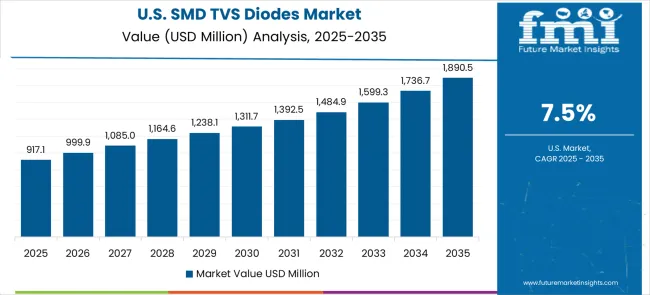
The United States is projected to grow at a CAGR of 7.5% from 2025 to 2035, supported by its strong electronics manufacturing base and high demand for circuit protection components in EVs, telecommunications, and industrial automation. SMD TVS diodes are vital in safeguarding high-speed electronics from transient overvoltage and ensuring operational reliability. USA manufacturers are integrating advanced automation and testing capabilities to maintain quality and efficiency. Government investment in domestic semiconductor fabrication and electronics production facilities supports demand growth. Expansion of EV and renewable energy sectors further enhances the market outlook. USA companies are also focusing on developing compact, high-performance diodes to address specialized applications.
The United Kingdom is expected to grow at a CAGR of 6.7% from 2025 to 2035, driven by demand in automotive electronics, renewable energy, and communication systems. SMD TVS diodes are valued for protecting sensitive components in high-speed circuits, particularly in electric vehicles and industrial automation systems. UK manufacturers are focusing on high-efficiency production and advanced testing techniques to ensure diode quality. Collaboration between electronics firms and academic research institutes is fostering innovation in diode materials and designs. Increasing export opportunities in high-performance electronics strengthen market growth. The adoption of automation in manufacturing further supports efficiency and consistency.
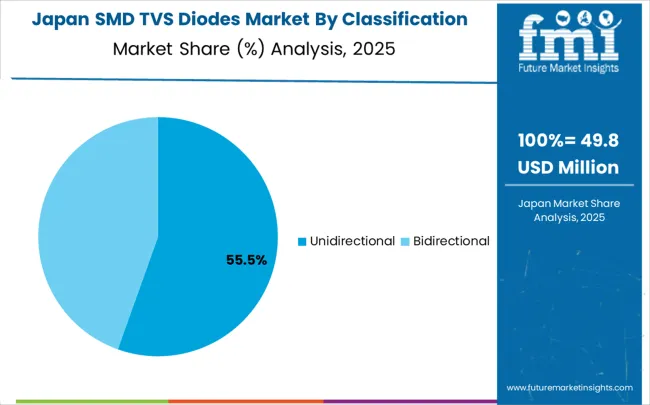
Japan is forecasted to grow at a CAGR of 5.9% from 2025 to 2035, supported by its strong electronics manufacturing base and technological innovation in circuit protection. Demand for SMD TVS diodes is driven by high-speed communications, automotive electronics, and industrial automation. Japanese manufacturers emphasize high-quality production with advanced automation and quality assurance systems. The focus is on compact, high-performance diode designs suitable for specialized applications. Strong collaborations between manufacturers and research institutes accelerate innovation. Japan’s high-value electronics exports steady demand for advanced diode solutions. These factors position Japan as a steady growth market for SMD TVS diodes.
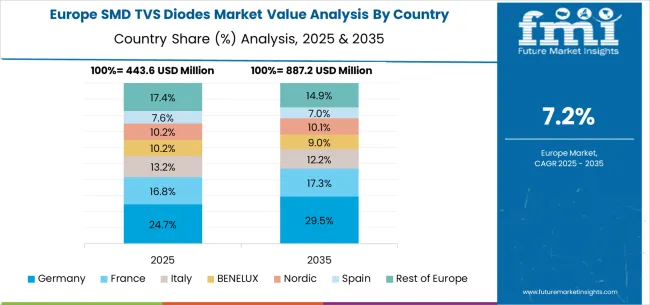
The SMD TVS diodes market in Europe is projected to grow from USD 498.4 million in 2025 to USD 756.8 million by 2035, registering a CAGR of 4.3% over the forecast period. Germany is expected to maintain its leadership with a 32.1% share in 2025, supported by its dominant automotive industry and advanced industrial automation infrastructure. The United Kingdom follows with 19.7% market share, driven by telecommunications infrastructure modernization and 5G deployment programs. France holds 16.4% of the European market, benefiting from aerospace industry requirements and consumer electronics manufacturing expansion. Italy and Spain collectively represent 18.6% of regional demand, with growing focus on automotive electronics and industrial equipment applications. The Rest of Europe region accounts for 13.2% of the market, supported by Nordic telecommunications advancement and Eastern European electronics manufacturing growth. Germany's automotive sector continues driving demand for specialized automotive-grade TVS diodes, while UK's digital infrastructure investments create opportunities for high-frequency protection solutions. France's aerospace and defense applications require premium-grade components, and Italy's industrial automation sector emphasizes reliability and performance optimization in protection devices.
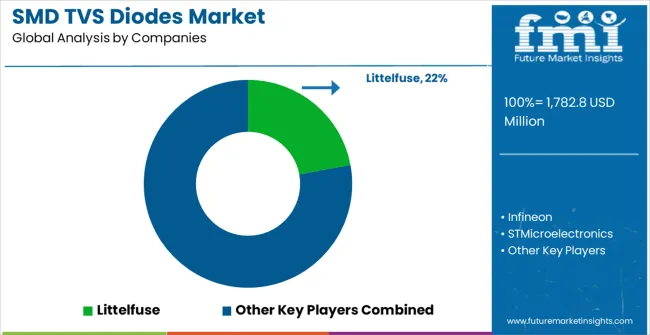
The market is defined by competition among established semiconductor manufacturers, specialized protection device companies, and integrated device manufacturers. Companies are investing in advanced semiconductor fabrication technologies, product innovation, standardized quality systems, and application engineering capabilities to deliver reliable, efficient, and cost-effective protection solutions. Strategic partnerships, technological advancement, and geographic expansion are central to strengthening product portfolios and market presence.
Littelfuse, operating globally, offers comprehensive TVS diode solutions with focus on application-specific design, reliability, and technical support services. Infineon, multinational, provides advanced protection devices with focus on automotive qualification and high-power handling capabilities. STMicroelectronics delivers specialized semiconductor protection solutions with focus on integration and system-level optimization. ON Semiconductor offers comprehensive TVS diode technologies with standardized procedures and global manufacturing support.
Diodes Incorporated provides specialized protection devices with focus on custom solutions and technical expertise. NXP delivers automotive-grade protection solutions with focus on system reliability and safety compliance. Toshiba offers comprehensive semiconductor protection technologies for consumer and industrial applications. Texas Instruments provides advanced protection devices with global manufacturing and engineering capabilities.
Vishay, Nexperia, Bourns, Semtech, ProTek Devices, Amazing Microelectronic, Taiwan Semiconductor, Micro Commercial Components, and Good-Ark Electronics offer specialized TVS diode expertise, regional manufacturing capabilities, and technical support across global and regional networks.
The SMD TVS diodes market underpins electronic device reliability, automotive safety systems, telecommunications infrastructure, and industrial automation efficiency. With rapid digitalization, miniaturization demands, and stringent automotive safety requirements, the sector faces pressure to balance performance optimization, cost competitiveness, and manufacturing scalability. Coordinated contributions from governments, industry bodies, OEMs/technology integrators, suppliers, and investors will accelerate the transition toward high-performance, digitally integrated, and application-specific TVS diode solutions.
| Item | Value |
|---|---|
| Quantitative Units | USD 1,782.8 million |
| Diode Type | Unidirectional Type, Bidirectional Type |
| Application | Consumer Electronics, Automotive, Industrial Automation, Telecommunications, Others |
| Regions Covered | North America, Europe, East Asia, South Asia & Pacific, Latin America, Middle East & Africa |
| Country Covered | United States, Germany, India, China, United Kingdom, Japan, Brazil, and other 40+ countries |
| Key Companies Profiled | Littelfuse, Infineon, STMicroelectronics, ON Semiconductor, Diodes Incorporated, NXP, Toshiba, Texas Instruments, Vishay, Nexperia, Bourns, Semtech |
The global SMD TVS diodes market is estimated to be valued at USD 1,782.8 million in 2025.
The market size for the SMD TVS diodes market is projected to reach USD 3,813.5 million by 2035.
The SMD TVS diodes market is expected to grow at a 7.9% CAGR between 2025 and 2035.
The key product types in SMD TVS diodes market are unidirectional and bidirectional.
In terms of application, consumer electronics segment to command 42.0% share in the SMD TVS diodes market in 2025.






Our Research Products

The "Full Research Suite" delivers actionable market intel, deep dives on markets or technologies, so clients act faster, cut risk, and unlock growth.

The Leaderboard benchmarks and ranks top vendors, classifying them as Established Leaders, Leading Challengers, or Disruptors & Challengers.

Locates where complements amplify value and substitutes erode it, forecasting net impact by horizon

We deliver granular, decision-grade intel: market sizing, 5-year forecasts, pricing, adoption, usage, revenue, and operational KPIs—plus competitor tracking, regulation, and value chains—across 60 countries broadly.

Spot the shifts before they hit your P&L. We track inflection points, adoption curves, pricing moves, and ecosystem plays to show where demand is heading, why it is changing, and what to do next across high-growth markets and disruptive tech

Real-time reads of user behavior. We track shifting priorities, perceptions of today’s and next-gen services, and provider experience, then pace how fast tech moves from trial to adoption, blending buyer, consumer, and channel inputs with social signals (#WhySwitch, #UX).

Partner with our analyst team to build a custom report designed around your business priorities. From analysing market trends to assessing competitors or crafting bespoke datasets, we tailor insights to your needs.
Supplier Intelligence
Discovery & Profiling
Capacity & Footprint
Performance & Risk
Compliance & Governance
Commercial Readiness
Who Supplies Whom
Scorecards & Shortlists
Playbooks & Docs
Category Intelligence
Definition & Scope
Demand & Use Cases
Cost Drivers
Market Structure
Supply Chain Map
Trade & Policy
Operating Norms
Deliverables
Buyer Intelligence
Account Basics
Spend & Scope
Procurement Model
Vendor Requirements
Terms & Policies
Entry Strategy
Pain Points & Triggers
Outputs
Pricing Analysis
Benchmarks
Trends
Should-Cost
Indexation
Landed Cost
Commercial Terms
Deliverables
Brand Analysis
Positioning & Value Prop
Share & Presence
Customer Evidence
Go-to-Market
Digital & Reputation
Compliance & Trust
KPIs & Gaps
Outputs
Full Research Suite comprises of:
Market outlook & trends analysis
Interviews & case studies
Strategic recommendations
Vendor profiles & capabilities analysis
5-year forecasts
8 regions and 60+ country-level data splits
Market segment data splits
12 months of continuous data updates
DELIVERED AS:
PDF EXCEL ONLINE
Electric Off-Road ATVs & UTVs Market Size and Share Forecast Outlook 2025 to 2035
Power Diodes Market
Limiter Diodes Market Size and Share Forecast Outlook 2025 to 2035
Schottky Diodes Market Size and Share Forecast Outlook 2025 to 2035
Field-effect Rectifier Diodes Market
High-Brightness Light-Emitting Diodes (LED) Headlamps Market Size and Share Forecast Outlook 2025 to 2035

Thank you!
You will receive an email from our Business Development Manager. Please be sure to check your SPAM/JUNK folder too.
Chat With
MaRIA